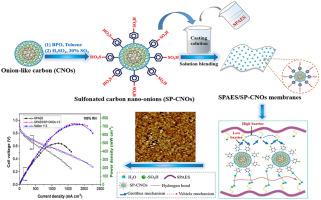Journal of Membrane Science ( IF 8.4 ) Pub Date : 2021-09-04 , DOI: 10.1016/j.memsci.2021.119823 Lili Liu 1 , Yao Lu 1 , Yangyang Pu 1 , Na Li 1 , Zhaoxia Hu 1 , Shouwen Chen 1

|
Highly sulfonated carbon nano-onions (SP–CNOs) with large specific surface area are used as a new type of nanofiller in sulfonated poly(arylene ether sulfone) (SPAES) to construct and adjust the proton transfer channels efficiently. SP-CNOs are synthesized from nanometer diamonds via thermal annealing, phenylation and sulfonation, and characterized by XRD, XPS, BET, Raman and HRTEM. The obtained mesoporous SP-CNOs possess a large specific surface of 350 m2/g and an average pore size of 9.7 nm, which endow the nanoparticles with good dispersivity and hydrophilicity. A series of composite membranes based on SP-CNOs/SPAES are prepared through the solution casting approach and evaluated by FESEM, XRD, TGA, water uptake, proton conductivity, chemical stability and fuel cell performance. The results indicate that the composite membranes all show excellent mechanical toughness and greatly enhanced water-retention capacity, thermal, dimensional and oxidative stability due to the good interfacial compatibility and the formation of hydrogen-bond interaction between SP-CNOs and SPAES. The SPAES/SP-CNOs-1.5 membrane achieves the highest proton conductivity of 181.2 mS/cm at 90 °C, which is 45% higher than that of SPAES; H2/O2 fuel cell performance records a power density of 735 mW/cm2 at 80 °C, which is slightly better than that of Nafion® 112. In addition, the SPAES/SP-CNOs-1.5 membrane undergoes the CV decay of 0.38 mV/h after 168 h at 80 °C, which is comparable to Nafion® 112 (0.43 mV/h) but lower than that for the pristine SPAES membrane (0.54 mV/h). After the accelerated stress test, the SPAES/SP-CNOs-1.5 membrane exhibits superior cell performance and lower hydrogen crossover than the pristine SPAES membrane.
中文翻译:

高度磺化碳纳米洋葱作为一种优异的纳米填料,用于制造具有增强保水性和耐久性的复合质子交换膜
具有大比表面积的高度磺化碳纳米洋葱(SP-CNOs)被用作磺化聚(亚芳基醚砜)(SPAES)中的一种新型纳米填料,以有效构建和调节质子传输通道。SP-CNOs 由纳米金刚石通过热退火、苯基化和磺化合成,并通过 XRD、XPS、BET、拉曼和 HRTEM 进行表征。获得的介孔 SP-CNOs 具有 350 m 2的大比表面积/g,平均孔径为9.7 nm,赋予纳米颗粒良好的分散性和亲水性。通过溶液浇铸方法制备了一系列基于SP-CNOs/SPAES的复合膜,并通过FESEM、XRD、TGA、吸水率、质子电导率、化学稳定性和燃料电池性能进行了评估。结果表明,由于良好的界面相容性以及 SP-CNOs 与 SPAES 之间形成的氢键相互作用,复合膜均表现出优异的机械韧性和显着增强的保水能力、热稳定性、尺寸稳定性和氧化稳定性。SPAES/SP-CNOs-1.5膜在90°C下达到了181.2 mS/cm的最高质子电导率,比SPAES高45%;H 2 /O 2燃料电池性能记录在 80 °C 时的功率密度为 735 mW/cm 2,略优于 Nafion® 112。此外,SPAES/SP-CNOs-1.5 膜的 CV 衰减为 0.38 mV/h在 80 °C 下 168 小时后,这与 Nafion® 112 (0.43 mV/h) 相当,但低于原始 SPAES 膜的 (0.54 mV/h)。在加速压力测试之后,SPAES/SP-CNOs-1.5 膜表现出比原始 SPAES 膜更优异的电池性能和更低的氢渗透。











































 京公网安备 11010802027423号
京公网安备 11010802027423号